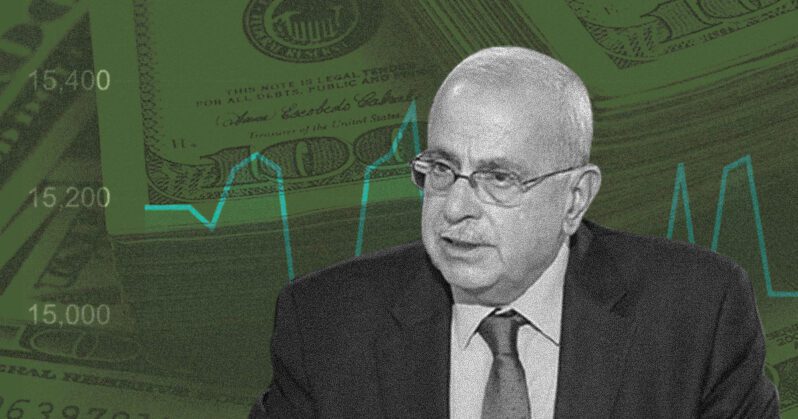Kamal Hamdan: Monopolies and Political Authority Continue to Profit from Lebanese Crisis

Since 2019, Lebanese citizens have lost their savings, the purchasing power of their salaries, and their social security nets combined. Overlapping political, economic, and social crises have driven the poverty rate to 85% and unemployment above 30%. These crises might have triggered a popular storm that nearly toppled the pillars of the ruling powers were it not for the deeply rooted sectarian system. Historically, this system has caused periodic crises, blocked solutions, and entrenched its control over the people by fueling their anxieties and fears, and replacing citizenship rights with clientelist interests until people fell silent. This is how researcher, economist, and director of the Consultation & Research Institute Kamal Hamdan summarizes the Lebanese situation. He deems that Lebanon is in freefall and witnessing the formation of a new social structure.
Our primary question was about “dollarization” and the development of the consumer price index in comparison to the development of the USD-to-LBP exchange rate. Hamdan and a statistics team from the institute have been publishing this index since 1977. The question stemmed from our conviction that dollarization is part of a general approach that the authority has adopted since the crisis began, one based on subjugating public interest to that of a small group in control. Inevitably, the discussion turned to the crisis, its repercussions, recovery, and how authorities have handled it.
“Dollarization”: Profits at the Citizen’s Expense
“Two days ago, I went to the store to buy a coffee pot, the same one I bought from the same store a year ago for USD10. I found that it was now priced at USD15. I asked why, and the seller responded that the price of the new imported batch was higher because of global inflation. I smiled and said that I’m an economist and as far as I know, the cumulative global inflation rate over two years is no higher than 20%. Hence, the pot should cost USD12 at most. So where did the extra USD3 come from? And why do you add 5-10% of the USD’s market price in LBP if we pay with the national currency? Is your salary, paid in LBP, adjusted in accordance with the development of the USD’s market price?”
Hamdan tells this story, which applies to all goods, when we asked him about dollarization and the USD exchange rate index relative to the price index. From there, he explains how “dollarization” becomes synonymous with exploiting citizens and procuring extra profits for merchants and monopolists. He adds that the biggest crime occurs when merchants use USD pricing to inflate their illegitimate profit margin by raising the price of commodities based on the black market exchange rate even though not all their costs are “dollarized” and governed by that rate. Cost items not directly dollarized include employees’ wages (labor cost), taxes, fees, social security contributions, rent, and part of the costs of electricity, water, and depreciation. He says, “Combined, these items and other non-dollarized items might reach approximately 50%. But in reality, every time the price of the USD rises, the percent increase is added to all items”.
The unjustified profit margin can be understood by following the trend in the development of the price index relative to the development of the USD exchange rate index since the 1970s. Hamdan says that in the period before the exchange rate was pegged, i.e. from 1977 to 1997 with the exception of two years in the mid-1980s, the annual percentage increase in the price index always exceeded the annual percentage increase in the USD-to-LBP exchange rate. After the exchange rate was pegged in 1997, the consumer price index continued its cumulative increase, reaching 121% in 2012. This divergent trend covers up vast capitalist profits.
According to Hamdan, the rise of consumer prices in Lebanon despite the pegged exchange rate reflected the depth and leverage of a network of monopolies controlling the type and price of Lebanon’s imports, especially the monopolies over fuel, medicine, grain, agricultural production supplies, and health sector supplies. These cartels were and still are protected and embraced by the alliance of the ruling forces and religious establishment.
Hamdan recalls a 2003 study that the Consultation & Research Institute conducted in collaboration with economist Toufic Gaspard and at the behest of late Minister of Economy Bassel Fleihan. The study examined the degree of centralization of economic activity in Lebanon, i.e. the reality of monopolization and competition. Based on a detailed statistical database of approximately 7,000 companies then registered with the General Directorate for Value Added Tax, the study showed that these companies were distributed across approximately 300 definable markets, and that in each of these markets, just three companies controlled 70% of market activity.
Amidst such monopoly, weak state oversight, and dysfunctional and deficient legislation, the concept of public interest was vanishing at the citizens’ expense, just as is occurring more brazenly now.
According to Hamdan, “When the financial and economic collapse began in 2019, a variant (if not inverse) relationship emerged between the development of the price index and the development of the exchange rate”. Contrary to the preceding period, the rate of increase in the USD-to-LBP exchange rate exceeded the rate of increase in the consumer price index. In December 2020, the USD price index had risen 243% relative to December 2019, whereas the price index rose 73% over the same period. Then the rates of increase in the two indices began converging in 2021, with the annual increase in the exchange rate reaching 189% in December 2021 versus a 173% increase in the commodities price index. In 2022, the direction changed completely, with the price of the USD rising 93% by the end of the year versus a 173% rise in prices. We will have to wait and see whether this change continues in 2023. Hamdan says that the trend in the relationship between the two indices cannot be predicted until the effects of several factors – including the end of subsidies, the crude and haphazard dollarization of prices, and the successive increases in rate quoted by the exchange platform Sayrafa sanctioned by the central bank and the black market USD’s effect on it – become clear.
The USD Peg and Economic Policies
The discussion of the crisis of the LBP and its relationship to the USD leads us into a discussion about the previous economic policies, which left their mark on the economic landscape. These policies are connected to what Hamdan calls the coup against the Taif Agreement and the supplanting of the state by a “crude alliance” between de facto sectarian rulers and the financial oligarchy.
He adds that the currency-pegging policy was adopted on the pretext of ending the nightmares that the Lebanese lived over the Civil War years because of the increase of the USD-to-LBP exchange rate by a factor of 1,000 (from LL3 to LL3,000). He explains that this policy, which was applied in many countries, was usually associated with a package of conditions, the most important being control over the state budget deficit, not expanding current spending, and the construction of infrastructure facilities. In the Lebanese case, none of these conditions existed.
He explains that the currency-pegging policy was used, in particular, to facilitate the purchase of political loyalties to the ruling elements. This is because pegging the exchange rate effectively increased the LBP’s exchange rate and created a false sense of social stability while also impeding export activity and facilitating import activity on a wide scale. Consequently, Lebanon recorded one of the highest rate of imports relative to domestic product for years (40% before the collapse).
Pegging to the USD is also associated, according to Hamdan, with raising interest rates and therefore with encouraging people to subsist off economic rent rather than produce or invest and to save their money to earn interest. Pegging the exchange rate was also accompanied by the abolishment of progressive taxation and lowered or even abolished protectionism, thereby reducing the contribution of the productive sectors – such as industry and agriculture – to the domestic product and the workforce by approximately half relative to the pre-war era.
Hamdan explains that all these policies aimed only to attract domestic and foreign loans to sustain the currency- peg system. They were accompanied by chaos and an unprecedented boom in public spending tainted by much corruption, low productivity, and clientelist interests that encourage evading accountability and refraining from auditing previous public budgets. Ultimately, they weakened the real economy and produced periodic crises requiring foreign intervention to keep the system afloat.
The Consequences of the Crisis in Numbers
Hamdan describes the current situation as the outcome of the policies adopted since the 1990s. No people in history, he says, have gone through what Lebanese people are currently going through. They have lost their savings, the value of their salaries, and their social security nets all at once and are now facing poverty, hunger, unemployment, and emigration. He explains that before the financial collapse, approximately 30% of the population was living beneath the upper poverty line, which represents the cost of food and drink to survive plus some non-food expenses. The upper poverty line on the eve of the collapse generally encompassed families with a gross monthly income of no more than USD1,200.
He explains that after 2019, the percentage of people living beneath the upper poverty line climbed to 70-85%, according to statistical estimates circulated by international organizations. Most gravely, the rate of abject poverty – i.e. people unable to secure their daily sustenance – rose from 10% before the crisis to approximately 30% after it.
The unemployment rate also climbed from 11% in 2018 (based on a Central Administration of Statistics study) to approximately 35% at the beginning of 2022. As for emigration, Hamdan says that figures circulating indicate that 200,000-250,000 Lebanese have emigrated since 2019. This figure is especially grave because most emigrants were workers, particularly skilled workers. Hence, 10-15% of the total workforce has left.
Adaption and a Sectarian System Still Going Strong
Amidst the crisis, the phrase “the people have adapted” is frequently repeated because the October 17 uprising has subsided and tourist facilities are packed. Hamdan says that the Lebanese people’s suffering in this unprecedented crisis would have raised a storm that toppled all pillars of the authority were it not for the sectarian system. To this day, the parties in power are still relatively capable of controlling and influencing people (see the results of the latest parliamentary elections) by continuing to encourage everyday anxiety and feelings of fear and cautiousness of the other. Another factor in the failure of the people to revolt against the authority in an organized manner is, according to Hamdan, the weakness of popular forces – including political, unionist, and democratic opposition forces – and their inability to facilitate the emergence of a mass of people capable of breaching the sectarian-classist political system.
In his opinion, the ruling forces still have a hold over their bases despite the decline in the clientelist services they provide due to the public sector’s collapse. These forces strive to create mixed alternatives for social protection, whether by distributing small in-kind or other benefits or soliciting aid from international organizations or embassies, which can reach no more than 5-10% of their social bases. Regarding the tourist facilities packed with people as though Lebanon is not suffering an economic crisis, he explains that the crisis has created a dichotomy in spending patterns and lifestyle between the majority who earn their income in LBP and employees, employers, and families of emigrants whose income consists partially or entirely of USD. The latter group constitutes only 15-20% of the population.
An Impending Crash and Neglected Solutions
Hamdan says that the state no longer has many tools and, because of its deficit, has limited all its interventions in the monetary realm to Banque du Liban. It has worked to adopt a collection of laws or bills marred by many pitfalls related to either their real goal or their applicability. He mentions the banking secrecy law, which satisfied not even the International Monetary Fund; the capital control law, which has not yet been adopted; and the law on judicial independence and anti-corruption measures as examples of the authority’s handling of the crisis. Meanwhile, what is needed is a holistic and comprehensive recovery plan that integrates all these legal reforms and defines the financial gap and the mechanism for distributing it. Beginning with the banking sector and its capital, financial and physical assets, as well as the top executive directors and shareholders, especially those who excessively enriched themselves through high interest rate policies over the years. This plan should be coupled with detailed applicatory decrees that ensure that the laws are implemented properly.
Hamdan believes that Lebanon is in freefall and witnessing the rise of a new social structure of unknown viability and durability, with the potential for much chaos. He says – albeit surrealistically and perhaps very optimistically – that the only hope for confronting this danger is to return to the beginning: working to form a popular mass that transcends the powerful sectarian and class alignments, build a national political and economic program to achieve democratic change, and establish the rules (even if flexible) for forming the leadership to pursue the implementation of this program.



